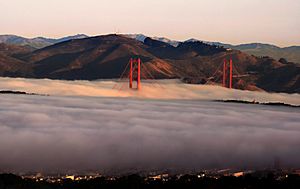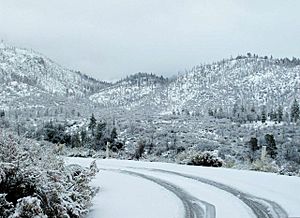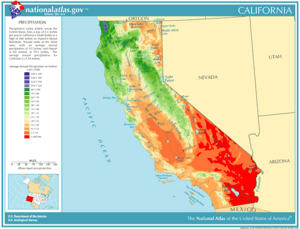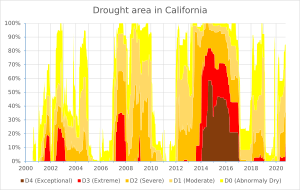Climate of California facts for kids
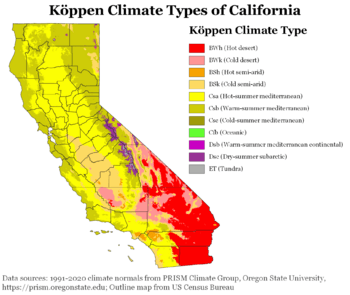

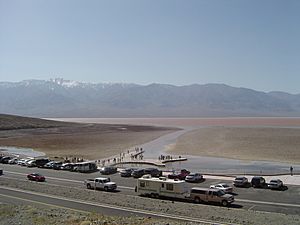
The weather in California can be very different from one place to another. You can find everything from hot, dry deserts to cold, snowy mountains. It all depends on how far north or south you are, how high up you are, and how close you are to the Pacific Ocean.
Many parts of California, like the coast and the large Central Valley, have a Mediterranean climate. This means they have warm, dry summers and cooler, wet winters. The ocean helps keep the weather mild along the coast. This makes winters warmer and summers cooler than in areas farther inland.
Contents
A State of Many Temperatures

The cool water of the Pacific Ocean often creates fog near the coast in the summer. This keeps coastal cities like San Francisco feeling cool. But if you travel just a short distance inland, the weather becomes much hotter and drier.
For example, in the summer, the average high temperature in San Francisco might be around 68 °F (20 °C). But in Walnut Creek, which is only about 20 miles (32 km) inland, the average high is 84 °F (28.9 °C). That's a big difference! The same thing happens in Southern California. Coastal cities like Santa Monica are much cooler in the summer than inland cities like Burbank.
Extremes of Hot and Cold
Some parts of California have very extreme temperatures.
- Hot Deserts: The southeastern part of the state has a hot desert climate. This is where you'll find Death Valley, one of the hottest places on Earth. In the summer, temperatures there often go above 120 °F (49 °C). The highest temperature ever reliably recorded in the world, 134 °F (56.7 °C), was in Death Valley on July 10, 1913.
- Cold Mountains: In contrast, the high Sierra Nevada mountains are much cooler. The town of Bodie, which is very high up at 8,379 feet or 2,554 metres, is one of the coldest places in the state. It can freeze there even in the middle of summer.
| Place | Jan | Feb | Mar | Apr | May | Jun | Jul | Aug | Sep | Oct | Nov | Dec |
|---|---|---|---|---|---|---|---|---|---|---|---|---|
| Alturas | 44 / 18 (7 / −8) |
48 / 21 (9 / −6) |
54 / 25 (12 / −4) |
60 / 28 (16 / −2) |
70 / 34 (21 / 1) |
79 / 40 (26 / 4) |
90 / 44 (32 / 7) |
89 / 42 (32 / 6) |
80 / 36 (27 / 2) |
68 / 28 (20 / −2) |
52 / 23 (11 / −5) |
42 / 18 (6 / −8) |
| Bakersfield | 56 / 39 (13 / 4) |
63 / 42 (17 / 6) |
69 / 47 (21 / 8) |
75 / 50 (24 / 10) |
84 / 58 (29 / 14) |
91 / 64 (33 / 18) |
97 / 71 (36 / 22) |
96 / 69 (36 / 21) |
90 / 64 (32 / 18) |
80 / 55 (27 / 13) |
66 / 45 (19 / 7) |
57 / 39 (14 / 4) |
| Bishop | 54 / 23 (12 / −5) |
58 / 27 (14 / −3) |
66 / 31 (19 / −1) |
73 / 36 (23 / 2) |
82 / 44 (28 / 7) |
92 / 51 (33 / 11) |
98 / 56 (37 / 13) |
96 / 54 (36 / 12) |
88 / 47 (31 / 8) |
76 / 37 (24 / 3) |
63 / 28 (17 / −2) |
53 / 22 (12 / −6) |
| Bodie | 40 / 5 (4 / −15) |
41 / 7 (5 / −14) |
45 / 11 (7 / −12) |
50 / 17 (10 / −8) |
61 / 24 (16 / −4) |
70 / 30 (21 / −1) |
78 / 34 (26 / 1) |
77 / 32 (25 / 0) |
71 / 26 (22 / −3) |
60 / 18 (16 / −8) |
49 / 11 (9 / −12) |
41 / 6 (5 / −14) |
| Death Valley | 67 / 40 (19 / 4) |
73 / 46 (23 / 8) |
82 / 55 (28 / 13) |
91 / 62 (33 / 17) |
101 / 73 (38 / 23) |
110 / 81 (43 / 27) |
117 / 88 (47 / 31) |
115 / 86 (46 / 30) |
107 / 76 (42 / 24) |
93 / 62 (34 / 17) |
77 / 48 (25 / 9) |
65 / 38 (18 / 3) |
| Eureka | 56 / 41 (13 / 5) |
56 / 42 (13 / 6) |
57 / 43 (14 / 6) |
58 / 44 (14 / 7) |
60 / 48 (16 / 9) |
62 / 50 (17 / 10) |
63 / 52 (17 / 11) |
64 / 53 (18 / 12) |
64 / 50 (18 / 10) |
62 / 47 (17 / 8) |
58 / 44 (14 / 7) |
55 / 41 (13 / 5) |
| Fresno | 55 / 38 (13 / 3) |
62 / 42 (17 / 6) |
68 / 46 (20 / 8) |
75 / 49 (24 / 9) |
84 / 56 (29 / 13) |
92 / 62 (33 / 17) |
98 / 68 (37 / 20) |
97 / 66 (36 / 19) |
91 / 62 (33 / 17) |
80 / 53 (27 / 12) |
65 / 43 (18 / 6) |
55 / 38 (13 / 3) |
| Los Angeles | 68 / 48 (20 / 9) |
69 / 49 (21 / 9) |
70 / 51 (21 / 11) |
73 / 54 (23 / 12) |
75 / 57 (24 / 14) |
78 / 60 (26 / 16) |
83 / 64 (28 / 18) |
84 / 64 (29 / 18) |
83 / 63 (28 / 17) |
79 / 59 (26 / 15) |
73 / 52 (23 / 11) |
68 / 48 (20 / 9) |
| Needles | 65 / 44 (18 / 7) |
70 / 47 (21 / 8) |
77 / 52 (25 / 11) |
85 / 59 (29 / 15) |
95 / 68 (35 / 20) |
104 / 77 (40 / 25) |
109 / 84 (43 / 29) |
107 / 83 (42 / 28) |
100 / 75 (38 / 24) |
88 / 62 (31 / 17) |
73 / 50 (23 / 10) |
63 / 43 (17 / 6) |
| Redding | 55 / 37 (13 / 3) |
60 / 39 (16 / 4) |
65 / 43 (18 / 6) |
71 / 46 (22 / 8) |
81 / 54 (27 / 12) |
90 / 61 (32 / 16) |
98 / 66 (37 / 19) |
97 / 63 (36 / 17) |
90 / 58 (32 / 14) |
78 / 50 (26 / 10) |
63 / 41 (17 / 5) |
55 / 36 (13 / 2) |
| Riverside | 69 / 43 (21 / 6) |
70 / 45 (21 / 7) |
73 / 46 (23 / 8) |
78 / 50 (26 / 10) |
83 / 55 (28 / 13) |
89 / 60 (32 / 16) |
95 / 64 (35 / 18) |
96 / 65 (36 / 18) |
92 / 61 (33 / 16) |
83 / 55 (28 / 13) |
75 / 47 (24 / 8) |
68 / 42 (20 / 6) |
| Sacramento | 54 / 39 (12 / 4) |
60 / 41 (16 / 5) |
65 / 44 (18 / 7) |
71 / 46 (22 / 8) |
80 / 51 (27 / 11) |
87 / 56 (31 / 13) |
92 / 58 (33 / 14) |
91 / 58 (33 / 14) |
87 / 56 (31 / 13) |
78 / 50 (26 / 10) |
64 / 43 (18 / 6) |
54 / 38 (12 / 3) |
| San Diego | 65 / 49 (18 / 9) |
65 / 51 (18 / 11) |
67 / 53 (19 / 12) |
68 / 56 (20 / 13) |
69 / 59 (21 / 15) |
71 / 62 (22 / 17) |
75 / 65 (24 / 18) |
76 / 67 (24 / 19) |
76 / 65 (24 / 18) |
73 / 61 (23 / 16) |
69 / 54 (21 / 12) |
65 / 48 (18 / 9) |
| San Francisco |
57 / 46 (14 / 8) |
60 / 48 (16 / 9) |
62 / 49 (17 / 9) |
63 / 49 (17 / 9) |
64 / 51 (18 / 11) |
66 / 53 (19 / 12) |
66 / 54 (19 / 12) |
68 / 55 (20 / 13) |
70 / 55 (21 / 13) |
69 / 54 (21 / 12) |
63 / 50 (17 / 10) |
57 / 46 (14 / 8) |
| San Jose | 58 / 42 (14 / 6) |
62 / 45 (17 / 7) |
66 / 47 (19 / 8) |
69 / 49 (21 / 9) |
74 / 52 (23 / 11) |
79 / 56 (26 / 13) |
82 / 58 (28 / 14) |
82 / 58 (28 / 14) |
80 / 57 (27 / 14) |
74 / 53 (23 / 12) |
64 / 46 (18 / 8) |
58 / 42 (14 / 6) |
| Santa Rosa | 59 / 39 (15 / 4) |
63 / 41 (17 / 5) |
67 / 43 (19 / 6) |
70 / 45 (21 / 7) |
75 / 48 (24 / 9) |
80 / 52 (27 / 11) |
82 / 52 (28 / 11) |
83 / 53 (28 / 12) |
83 / 52 (28 / 11) |
78 / 48 (26 / 9) |
67 / 43 (19 / 6) |
59 / 39 (15 / 4) |
| South Lake Tahoe |
43 / 16 (6 / −9) |
44 / 18 (7 / −8) |
49 / 23 (9 / −5) |
54 / 27 (12 / −3) |
64 / 32 (18 / 0) |
72 / 37 (22 / 3) |
81 / 41 (27 / 5) |
80 / 40 (27 / 4) |
74 / 35 (23 / 2) |
63 / 28 (17 / −2) |
51 / 22 (11 / −6) |
43 / 17 (6 / −8) |
Statewide Records
The highest temperature ever recorded in California was 134 °F (56.7 °C) in Death Valley on July 10, 1913. This is also the highest temperature ever recorded on Earth. The lowest temperature ever recorded in the state was −45 °F (−42.8 °C) in Boca on January 20, 1937.
| Climate data for California | |||||||||||||
|---|---|---|---|---|---|---|---|---|---|---|---|---|---|
| Month | Jan | Feb | Mar | Apr | May | Jun | Jul | Aug | Sep | Oct | Nov | Dec | Year |
| Record high °F (°C) | 97 (36) |
102 (39) |
108 (42) |
118 (48) |
124 (51) |
129 (54) |
134 (57) |
130 (54) |
127 (53) |
118 (48) |
105 (41) |
100 (38) |
134 (57) |
| Record low °F (°C) | −45 (−43) |
−43 (−42) |
−35 (−37) |
−30 (−34) |
−15 (−26) |
2 (−17) |
12 (−11) |
12 (−11) |
−5 (−21) |
−20 (−29) |
−28 (−33) |
−40 (−40) |
−45 (−43) |
| Source: https://www.infoplease.com/science-health/weather/california-temperature-extremes | |||||||||||||
Rain and Snow in California
Winds blowing from the Pacific Ocean bring moisture to California. The northern parts of the state usually get more rain than the southern parts. The state's tall mountain ranges also have a big effect on the weather.
When moist air from the ocean hits a mountain, it is forced to rise and cool down. This causes the moisture to fall as rain or snow. This is why the western slopes of mountains are often the rainiest parts of the state. Northwestern California can get between 15 inches (380 mm) and 50 inches (1,300 mm) of rain each year. Some forests of giant Coast Redwood trees get over 100 inches (2,500 mm) of rain.
After the air crosses the mountains, it sinks and warms up, holding onto its moisture. This creates a dry area called a rain shadow on the eastern side of the mountains. This is why California's deserts, like the Mojave Desert, are located east of the major mountain ranges.
In the winter, the high mountains get a lot of snow. Ski resorts near Lake Tahoe and Mammoth Lakes can get over 10 feet (3.0 m) of snow in one season.
El Niño and La Niña
Big weather patterns in the Pacific Ocean, like El Niño and La Niña, can change how much rain and snow California gets.
- During an El Niño year, the winter is often warmer and wetter, especially in Southern California.
- During a La Niña year, Northern California tends to be wetter, while the southern half of the state stays cooler and drier.
The Famous California Fog
Fog is common along the coast, especially in the summer. But in the winter, California's Central Valley can get a special kind of thick fog called tule fog.
Tule fog is named after the tule grasses that grow in the valley's wetlands. It forms on clear, calm nights and can be so thick that you can't see more than a few feet in front of you. This makes it very dangerous for drivers. Because of the danger, there are now special fog warning systems on major highways like State Route 99.
Does California Get Tornadoes?
Yes, California does get tornadoes, but they are usually much weaker and don't last as long as the tornadoes in the central United States. They are most common in the Los Angeles area, the Central Valley, and the southern deserts.
In July 2004, a tornado touched down in Sequoia National Park at an altitude of about 12,156 ft (3,705 m). This was the highest-elevation tornado ever confirmed in the United States.
What About Hurricanes?
Even though California has a long coastline, tropical cyclones (like hurricanes) are extremely rare. This is because the ocean water off the coast is very cold due to the California Current. Hurricanes need warm water to form and stay strong.
While a direct hit from a hurricane is unlikely, the leftover moisture from storms that weaken over the ocean can sometimes reach California and cause heavy rain.
Wildfire Season
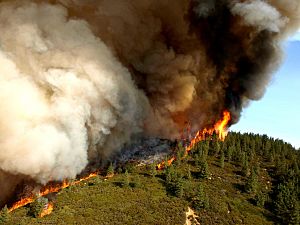
In the summer, inland parts of California can get very hot, with temperatures often over 100 °F (38 °C). It also rains very little during this time. These hot, dry conditions make it easy for wildfires to start and spread quickly.
Wildfires can be very dangerous and sometimes force people to leave their homes. They are most common in the late summer and fall. Sometimes, strong winds can make the fires even worse. On rare occasions, a wildfire can create a spinning column of fire and wind called a fire whirl, which is like a tornado made of fire.
Powerful Winds
In February 2017, a powerful winter storm produced an amazing wind gust of 199 mph (320 km/h) at a ski resort in the Sierra Nevada mountains. That's as strong as the winds in a major hurricane!
California Weather Words
Here are some special terms people use to talk about the weather in California.
- Marine layer: A layer of cool, moist air that blows in from the ocean. It often brings clouds and fog to the coast, especially from late spring to early fall.
- May Gray and June Gloom: This is what people call the cloudy, overcast weather that often covers coastal areas in the late spring.
- Pineapple Express: A weather pattern that brings a long stream of warm, moist air from near Hawaii all the way to California. This can cause very heavy, non-stop rain for several days.
- Santa Ana winds: These are strong, hot, and very dry winds that blow from the deserts toward the coast of Southern California. They usually happen in the spring and fall. As the air flows down from the high mountains, it heats up and dries out, which can create dangerous wildfire conditions.
- Tule fog: The thick fog that forms in the Central Valley during the fall and winter.
See also
 In Spanish: Clima de California para niños
In Spanish: Clima de California para niños
- Climate change in California
- Climate of southern California
- Floods in California


